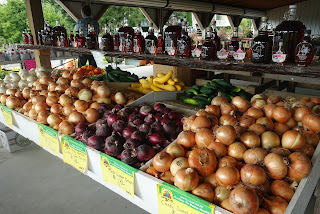Ever since the slogan "Ithaca is Gorges," was a popular bumper sticker, I
had wanted to explore the Finger Lakes region of New York State. There are lots of gorges in the Finger Lakes, and Ithaca has its
share, but Watkins Glen, billed as one of the most stunning places in
the State of New York and one of the most popular
state parks in the United States, sounded intriguing.
When my friend, Karen, and I discovered that we both had been wishing to visit the area, while our husbands were fairly disinterested, we teamed up in March and made lodging reservations for mid-September.
 |
| (Catharine Creek in front of our cottage) |
Camping is Karen's and my usual MO for overnights but we decided to pamper ourselves with "real" accommodations this time. Looking online, I found Catharine's Cottages just south of Watkins Glen on Catherine Creek in Montour Falls.
At the same time, Karen discovered that the cottages were next to the Catharine Valley Rail Trail, a perfect 13-mile bike ride for us. And so we took off with our bikes and hiking boots, leaving the tent and husbands behind.
 |
| (fascinating rock carved by Glen Creek at Watkins Glen State Park) |
It rained all night and continued into the morning. Even as we pulled into Watkins Glen State Park, rain pounded the car's roof. Fortunately, as predicted, it let up shortly after we went through the park's gate.
Karen and I loved walking the 1.5 mile Gorge Trail with its 19 waterfalls. I was also taken with the serpentine rock formed over thousands of years by the rushing water.
 | |
| (Virginia behind the waterfall) |
In addition, man-made rock work was spectacular. The Civilian Conservation Corps, a back-to-work program as part of Roosevelt's New Deal, constructed trails and stone work in over 800 parks in its 9-year existence. Although very familiar with the CCC's work at home and elsewhere, we wondered how men survived the dangerous trail and bridge construction next to or above tumultuous waterfalls and the roiling river.
 |
| (Rainbow Falls) |
Rainbow Falls has it all: a delicate waterfall that sprinkles the tourist who walks beneath; the fast billowing Glen Creek; a flight of stone steps that rise to a stone bridge; and the water-carved limestone and shale sedimentary rock formed over 10,000 years. Rainbow Falls' beauty has made it the most photographed waterfall in the park.
 |
| (Central Cascade) |
At 60 feet high, the Central Cascade is the tallest waterfall in the park. Might the bridge builders here have been afraid they might slip and tumble? Every turn in the path held new fascination for us.
And what about those 832 steps throughout the gorge? As veteran hikers, Karen and I had no trouble climbing them. We had brought our hiking poles, since we were new to the park and hadn't known what to expect, but we did not need them.
 |
| (Karen on a grand flight of stairs) |
We ended our stair climb at Jacob's Ladder, which alone is comprised of 180 steps. At the top, we took the Indian Trail, making a loop return to where we had begun. After watching our steps on rocks and stairs in the gorge, it felt good to stride right along on this pretty trail.
And just as we made our final ascent to the parking lot, the sun came out in earnest.
| (Iconic view at Watkins Glen marina on Seneca Lake) |
Once out of the park, it didn't take us long to decide to stop at Captain Bill's and get tickets for a 50-minute boat ride on Seneca Lake. The water sparkled under the sunny blue sky as we boarded the Seneca Legacy.
















